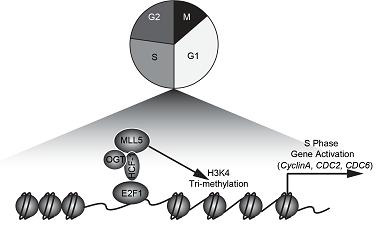Mixed Lineage Leukemia 5 (MLL5) protein is a major member of histone H3K4 methyltransfereases, Its coding gene Mll5was located within chromosome band 7q22, which is frequently deleted in human acute myeloid leukemia. The previous study of Mll5 gene knockout mouse indicated that Mll5 gene is an important regulator of the hematopoietic stem cell, but the molecular mechanism of the process was still unclear.
The 3rd year master student Zhou Peipei and the research assistant Wang Zhilong from Zhang Yan’s lab of Institut Pasteur of Shanghai, Chinese Academy of Sciences (IPS-CAS) found a novel molecular mechanism of MLL5 protein in the regulation of the cell cycle progression. This new finding prepared for further studying the mechanism of MLL5 in regulating the hematopoiesis self-renewal.
In this study, researchers found that the MLL5 protein associates with HCF-1, knockdown the MLL5 protein results in reduced cell proliferation and cell cycle arrest at the G1 phase. Moreover, down-regulation of the E2F1 target gene expression and decreased H3K4me3 levels at E2F1-responsive promoters. Additionally, knockdown the HCF-1 protein impaired the binding of MLL5 protein at E2F1-responsive promoters.
Moreover, researchers found that the core subunits, including ASH2L, RBBP5, and WDR5, which are necessary for effective H3K4 methyltransferase activities of the Trithorax protein complexes, were absent in the MLL5 complex, suggesting that a distinct mechanism may be used by MLL5 for exerting its H3K4 methyltransferase activity.
Together, researchers revealed a novel molecular mechanism that MLL5 could associate with HCF-1 and then be recruited to E2F1-responsive promoters to stimulate H3K4 trimethylation and transcriptional activation, thereby facilitating the cell cycle G1-to-S phase transition .
On April 29, the results were published in the Journal of Biological Chemistry, entitled ‘Mixed Lineage Leukemia 5 (MLL5) Protein Regulates Cell Cycle Progression and E2F1-responsive Gene Expression via Association with Host Cell Factor-1 (HCF-1)’.
This research was supported by grants from National Natural Science Foundation of China, the Ministry of Science and Technology of China, and Chinese Academy of Sciences.

Figure: Model for MLL5 mediated cell cycle control.

